Crustal Structure of the Eastern Anatolia Region (Turkey) Based on Seismic Tomography
Abstract
1. Introduction
2. Data and Method
3. Seismic Tomography Models and Tests
4. Discussion and Interpretation
5. Conclusions
Author Contributions
Funding
Data Availability Statement
Conflicts of Interest
References
- Okay, A.I.; Zattin, M.; Cavazza, W. Apatite fission-track data for the Miocene Arabia-Eurasia collision. Geology 2010, 38, 35–38. [Google Scholar] [CrossRef]
- Mueller, M.A.; Licht, A.; Campbell, C.; Ocakoğlu, F.; Taylor, M.H.; Burch, L.; Ugrai, T.; Kaya, M.; Kurtoğlu, B.; Coster, P.M.C.; et al. Collision Chronology Along the İzmir-Ankara-Erzincan Suture Zone: Insights From the Sarıcakaya Basin, Western Anatolia. Tectonics 2019, 38, 3652–3674. [Google Scholar] [CrossRef]
- Tan, O.; Taymaz, T. Active tectonics of the Caucasus: Earthquake source mechanisms and rupture histories obtained from inversion of teleseismic body waveforms. Spec. Pap. Geol. Soc. Am. 2006, 409, 531. [Google Scholar]
- McClusky, S.; Balassanian, S.; Barka, A.; Demir, C.; Ergintav, S.; Georgiev, I.; Gurkan, O.; Hamburger, M.; Hurst, K.; Kahle, H.; et al. Global Positioning System constraints on plate kinematics and dynamics in the eastern Mediterranean and Caucasus. J. Geophys. Res. Solid Earth 2000, 105, 5695–5719. [Google Scholar]
- Yıldırım, C.; Sarıkaya, M.A.; Çiner, A. Late Pleistocene intraplate extension of the Central Anatolian Plateau, Turkey: Inferences from cosmogenic exposure dating of alluvial fan, landslide, and moraine surfaces along the Ecemiş Fault Zone. Tectonics 2016, 35, 1446–1464. [Google Scholar] [CrossRef]
- Özacar, A.A.; Zandt, G.; Gilbert, H.; Beck, S.L. Seismic images of crustal variations beneath the East Anatolian Plateau (Turkey) from teleseismic receiver functions. Geol. Soc. Spec. Publ. 2010, 340, 485–496. [Google Scholar] [CrossRef]
- Şengör, A.M.C.; Yilmaz, Y. Tethyan evolution of Turkey: A plate tectonic approach. Tectonophysics 1981, 75, 181–241. [Google Scholar] [CrossRef]
- Allen, M.; Jackson, J.; Walker, R. Late Cenozoic reorganization of the Arabia-Eurasia collision and the comparison of short-term and long-term deformation rates. Tectonics 2004, 23. [Google Scholar] [CrossRef]
- Dewey, J.F.; Hempton, M.R.; Kidd, W.S.F.; Saroglu, F.; Şengör, A.M.C. Shortening of continental lithosphere: The neotectonics of Eastern Anatolia - A young collision zone. Geol. Soc. Spec. Publ. 1986, 19, 1–36. [Google Scholar] [CrossRef]
- Keskin, M. Magma generation by slab steepening and break-off beneath a subduction-accretion complex: An alternative model for collision-related volcanism in Eastern Anatolia, Turkey. Geophys. Res. Lett. 2003, 30, 7–10. [Google Scholar] [CrossRef]
- Şengör, A.M.C.; Özeren, S.; Genç, T.; Zor, E. East Anatolian High Plateau as a mantle-supported, north-south shortened domal structure. Geophys. Res. Lett. 2003, 30, 2–5. [Google Scholar] [CrossRef]
- Yilmaz, Y. Comparison of young volcanic associations of western and eastern Anatolia formed under a compressional regime: A review. J. Volcanol. Geotherm. Res. 1990, 44, 69–87. [Google Scholar] [CrossRef]
- Schleiffarth, W.K.; Darin, M.H.; Reid, M.R.; Umhoefer, P.J. Dynamics of episodic Late Cretaceous-Cenozoic magmatism across Central to Eastern Anatolia: New insights from an extensive geochronology compilation. Geosphere 2018, 14, 1990–2008. [Google Scholar] [CrossRef]
- Rabayrol, F.; Hart, C.J.R.; Thorkelson, D.J. Temporal, spatial and geochemical evolution of late Cenozoic post-subduction magmatism in central and eastern Anatolia, Turkey. Lithos 2019, 336, 67–96. [Google Scholar]
- Şengör, A.M.C.; Kidd, W.S.F. Post-collisional tectonics of the Turkish-Iranian plateau and a comparison with Tibet. Tectonophysics 1979, 55, 361–376. [Google Scholar] [CrossRef]
- Vanacore, E.A.; Taymaz, T.; Saygin, E. Moho structure of the anatolian plate from receiver function analysis. Geophys. J. Int. 2013, 193, 329–337. [Google Scholar] [CrossRef]
- Tezel, T.; Shibutani, T.; Kaypak, B. Crustal structure variation in western Turkey inferred from the receiver function analysis. Tectonophysics 2010, 492, 240–252. [Google Scholar]
- Zor, E.; Sandvol, E.; Gürbüz, C.; Türkelli, N.; Seber, D.; Barazangi, M. The crustal structure of the East Anatolian plateau (Turkey) from receiver functions. Geophys. Res. Lett. 2003, 30. [Google Scholar] [CrossRef]
- Gök, R.; Pasyanos, M.E.; Zor, E. Lithospheric structure of the continent-continent collision zone: Eastern Turkey. Geophys. J. Int. 2007, 169, 1079–1088. [Google Scholar] [CrossRef]
- Gans, C.R.; Beck, S.L.; Zandt, G.; Biryol, C.B.; Ozacar, A.A. Detecting the limit of slab break-off in central Turkey: New high-resolution Pn tomography results. Geophys. J. Int. 2009, 179, 1566–1572. [Google Scholar]
- Memiş, C.; Göğüş, O.H.; Uluocak, E.Ş.; Pysklywec, R.; Keskin, M.; Şengör, A.M.C.; Topuz, G. Long Wavelength Progressive Plateau Uplift in Eastern Anatolia Since 20 Ma: Implications for the Role of Slab Peel-Back and Break-Off. Geochem. Geophy. Geosys. 2020, 21. [Google Scholar] [CrossRef]
- Pearce, J.A.; Bender, J.F.; De Long, S.E.; Kidd, W.S.F.; Low, P.J.; Güner, Y.; Saroglu, F.; Yilmaz, Y.; Moorbath, S.; Mitchell, J.G. Genesis of collision volcanism in Eastern Anatolia, Turkey. J. Volcanol. Geotherm. Res. 1990, 44, 189–229. [Google Scholar] [CrossRef]
- Koulakov, I.; Zabelina, I.; Amanatashvili, I.; Meskhia, V. Nature of orogenesis and volcanism in the Caucasus region based on results of regional tomography. Solid Earth 2012, 3, 327–337. [Google Scholar] [CrossRef]
- Zabelina, I.; Koulakov, I.; Amanatashvili, I.; El Khrepy, S.; Al-Arifi, N. Seismic structure of the crust and uppermost mantle beneath Caucasus based on regional earthquake tomography. J. Asian Earth Sci. 2016, 119, 87–99. [Google Scholar] [CrossRef]
- Zor, E. Tomographic evidence of slab detachment beneath eastern Turkey and the Caucasus. Geophys. J. Int. 2008, 175, 1273–1282. [Google Scholar] [CrossRef]
- Lei, J.; Zhao, D. Teleseismic evidence for a break-off subducting slab under Eastern Turkey. Earth Planet. Sci. Lett. 2007, 257, 14–28. [Google Scholar] [CrossRef]
- Portner, D.E.; Delph, J.R.; Berk Biryol, C.; Beck, S.L.; Zandt, G.; Özacar, A.A.; Sandvol, E.; Türkelli, N. Subduction termination through progressive slab deformation across Eastern Mediterranean subduction zones from updated P-wave tomography beneath Anatolia. Geosphere 2018, 14, 907–925. [Google Scholar] [CrossRef]
- Kaban, M.K.; Petrunin, A.G.; El Khrepy, S.; Al-Arifi, N. Diverse Continental Subduction Scenarios Along the Arabia-Eurasia Collision Zone. Geophys. Res. Lett. 2018, 45, 6898–6906. [Google Scholar] [CrossRef]
- Al-Lazki, A.I.; Seber, D.; Sandvol, E.; Turkelli, N.; Mohamad, R.; Barazangi, M. Tomographic Pn velocity and anisotropy structure beneath the Anatolian plateau (eastern Turkey) and the surrounding regions. Geophys. Res. Lett. 2003, 30, 4–7. [Google Scholar] [CrossRef]
- Maggi, A.; Priestley, K. Surface waveform tomography of the Turkish-Iranian plateau. Geophys. J. Int. 2005, 160, 1068–1080. [Google Scholar] [CrossRef]
- Salah, M.K.; Şahin, Ş.; Topatan, U. Crustal velocity and Vp/Vs structures beneath central Anatolia from local seismic tomography. Arab. J. Geosci. 2014, 7, 4101–4118. [Google Scholar] [CrossRef]
- Warren, L.M.; Beck, S.L.; Biryol, C.B.; Ozacar, A.A.; Yang, Y. Crustal velocity structure of Central and Eastern Turkey from ambient noise tomography. Geophys. J. Int. 2013, 194, 1941–1954. [Google Scholar] [CrossRef]
- Salaün, G.; Pedersen, H.A.; Paul, A.; Farra, V.; Karabulut, H.; Hatzfeld, D.; Papazachos, C.; Childs, D.M.; Pequegnat, C.; Afacan, T.; et al. High-resolution surface wave tomography beneath the Aegean-Anatolia region: Constraints on upper-mantle structure. Geophys. J. Int. 2012, 190, 406–420. [Google Scholar] [CrossRef]
- Angus, D.A.; Wilson, D.C.; Sandvol, E.; Ni, J.F. Lithospheric structure of the Arabian and Eurasian collision zone in eastern Turkey from S-wave receiver functions. Geophys. J. Int. 2006, 166, 1335–1346. [Google Scholar] [CrossRef]
- Salah, M.K.; Şahin, Ş.; Aydin, U. Seismic velocity and Poisson’s ratio tomography of the crust beneath East Anatolia. J. Asian Earth Sci. 2011, 40, 746–761. [Google Scholar] [CrossRef]
- Koulakov, I.; Bindi, D.; Parolai, S.; Grosser, H.; Milkereit, C. Distribution of seismic velocities and attenuation in the crust beneath the North Anatolian fault (Turkey) from local earthquake tomography. Bull. Seismol. Soc. Am. 2010, 100, 207–224. [Google Scholar] [CrossRef]
- Kaypak, B. Three-dimensional VP and VP/VS structure of the upper crust in the Erzincan basin (eastern Turkey). J. Geophys. Res. Solid Earth 2008, 113. [Google Scholar] [CrossRef]
- Yolsal-Çevikbilen, S.; Biryol, C.B.; Beck, S.; Zandt, G.; Taymaz, T.; Adiyaman, H.E.; Özacar, A.A. 3-D crustal structure along the North Anatolian Fault Zone in north-central Anatolia revealed by local earthquake tomography. Geophys. J. Int. 2012, 188, 819–849. [Google Scholar] [CrossRef]
- Karabulut, H.; Özalaybey, S.; Taymaz, T.; Aktar, M.; Selvi, O.; Kocaoǧlu, A. A tomographic image of the shallow crustal structure in the Eastern Marmara. Geophys. Res. Lett. 2003, 30, 1–4. [Google Scholar] [CrossRef]
- Polat, G.; Özel, N.M.; Koulakov, I. Investigating P-and S-wave velocity structure beneath the Marmara region (Turkey) and the surrounding area from local earthquake tomography. Earth Planets Sp. 2016, 68, 1–14. [Google Scholar] [CrossRef]
- Gökalp, H. Tomographic Imaging of the Seismic Structure Beneath the East Anatolian Plateau, Eastern Turkey. Pure Appl. Geophys. 2012, 169, 1749–1776. [Google Scholar] [CrossRef]
- Koulakov, I. LOTOS code for local earthquake tomographic inversion: Benchmarks for testing tomographic algorithms. Bull. Seismol. Soc. Am. 2009, 99, 194–214. [Google Scholar] [CrossRef]
- Zabelina, I.V.; Koulakov, I.Y.; Buslov, M.M. Deep mechanisms in the Kyrgyz Tien Shan orogen (from results of seismic tomography). Russ. Geol. Geophys. 2013, 54, 695–706. [Google Scholar] [CrossRef]
- Sychev, I.V.; Koulakov, I.; Sycheva, N.A.; Koptev, A.; Medved, I.; El Khrepy, S.; Al-Arifi, N. Collisional Processes in the Crust of the Northern Tien Shan Inferred From Velocity and Attenuation Tomography Studies. J. Geophys. Res. Solid Earth 2018, 123, 1752–1769. [Google Scholar] [CrossRef]
- Koulakov, I.; Gerya, T.; Rastogi, B.K.; Jakovlev, A.; Medved, I.; Kayal, J.R.; El Khrepy, S.; Al-Arifi, N. Growth of mountain belts in central Asia triggers a new collision zone in central India. Sci. Rep. 2018, 8, 1–8. [Google Scholar] [CrossRef] [PubMed]
- Koulakov, I.; Jakovlev, A.; Zabelina, I.; Roure, F.; Cloetingh, S.; El Khrepy, S.; Al-Arifi, N. Subduction or delamination beneath the Apennines? Evidence from regional tomography. Solid Earth 2015, 6, 669–679. [Google Scholar] [CrossRef]
- Um, J.; Thurber, C.A. Fast algorithm for two-point seismic ray tracing. Bull. Seismol. Soc. Am. 1987, 77, 972–986. [Google Scholar]
- Paige, C.C.; Saunders, M.A. LSQR: An algorithm for sparse linear equations and sparse least squares. ACM Trans. Math. Softw. 1982, 8, 43–71. [Google Scholar] [CrossRef]
- Nolet, G. Seismic wave propagation and seismic tomography. Seism. Tomogr. 1987, 1–23. Available online: https://link.springer.com/chapter/10.1007%2F978-94-009-3899-1_1 (accessed on 14 February 2021).
- Çivgin, B.; Kaypak, B. Estimation of the crustal structure in Central Anatolia (Turkey) using receiver functions. Turk. J. Earth Sci. 2017, 26, 314–330. [Google Scholar] [CrossRef]
- Oruç, B.; Gomez-Ortiz, D.; Petit, C. Lithospheric flexural strength and effective elastic thicknesses of the Eastern Anatolia (Turkey) and surrounding region. J. Asian Earth Sci. 2017, 150, 1–13. [Google Scholar] [CrossRef]
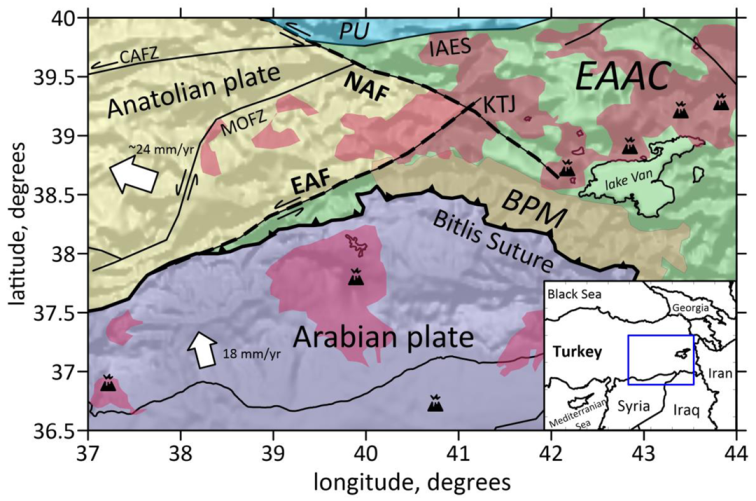
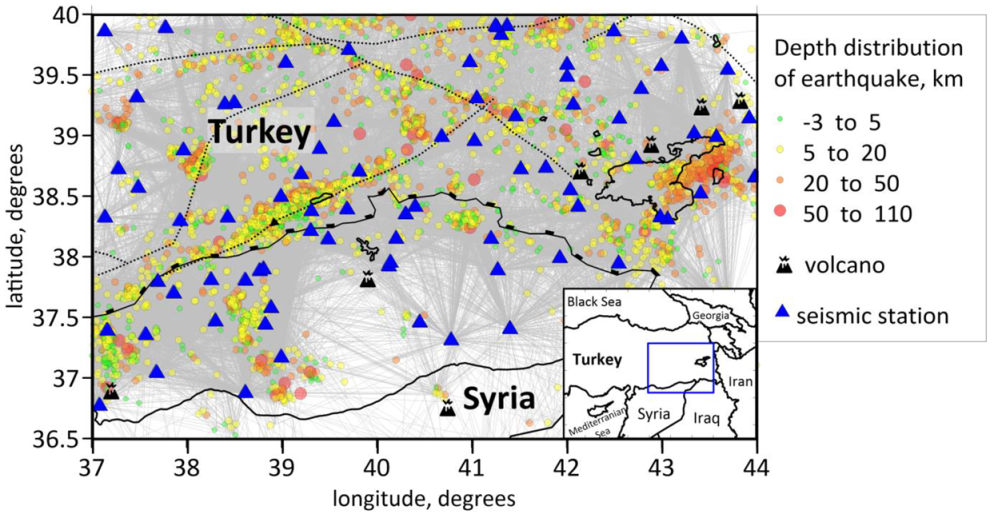

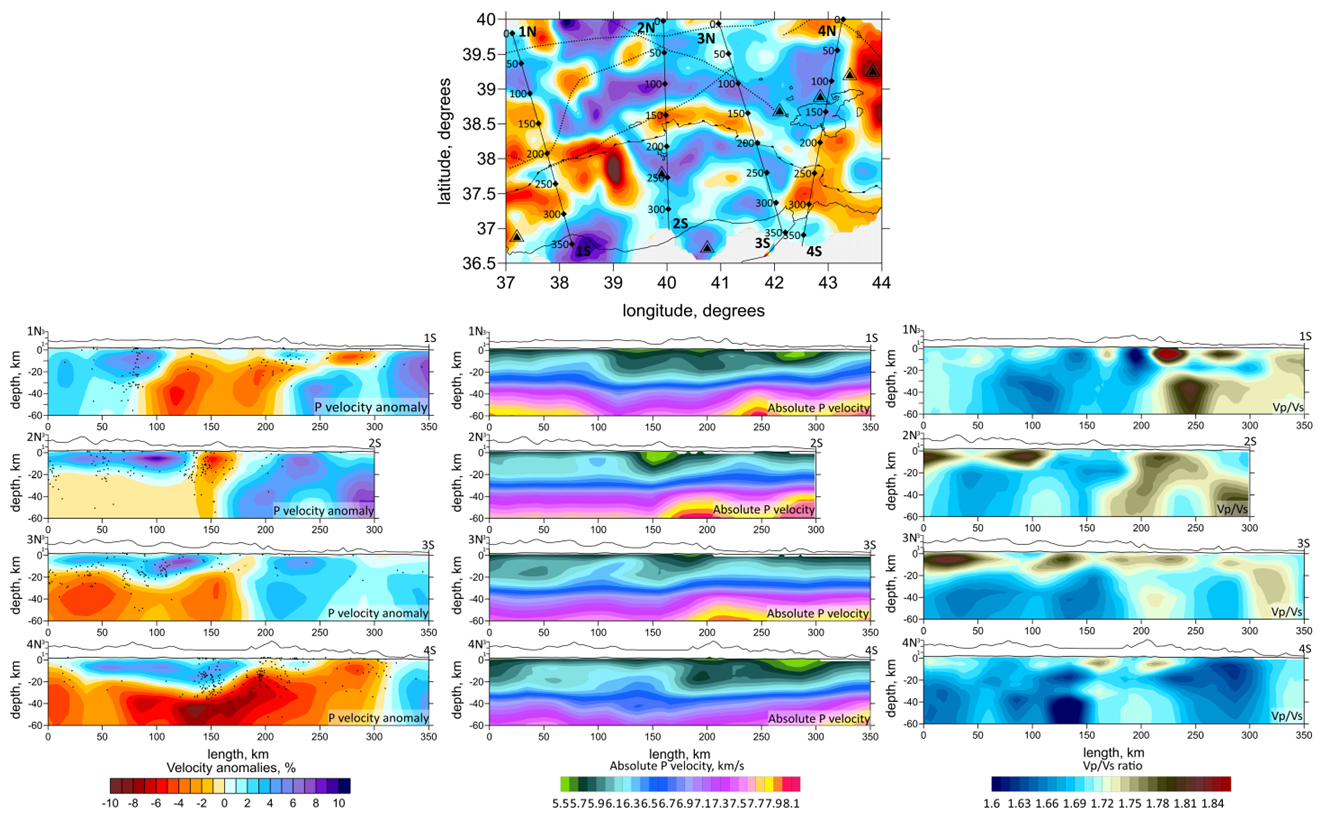

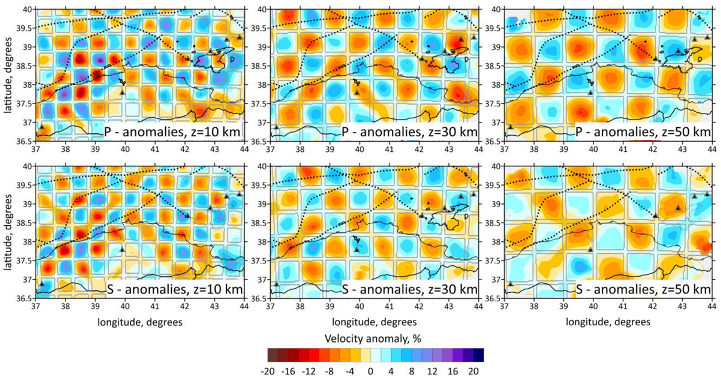
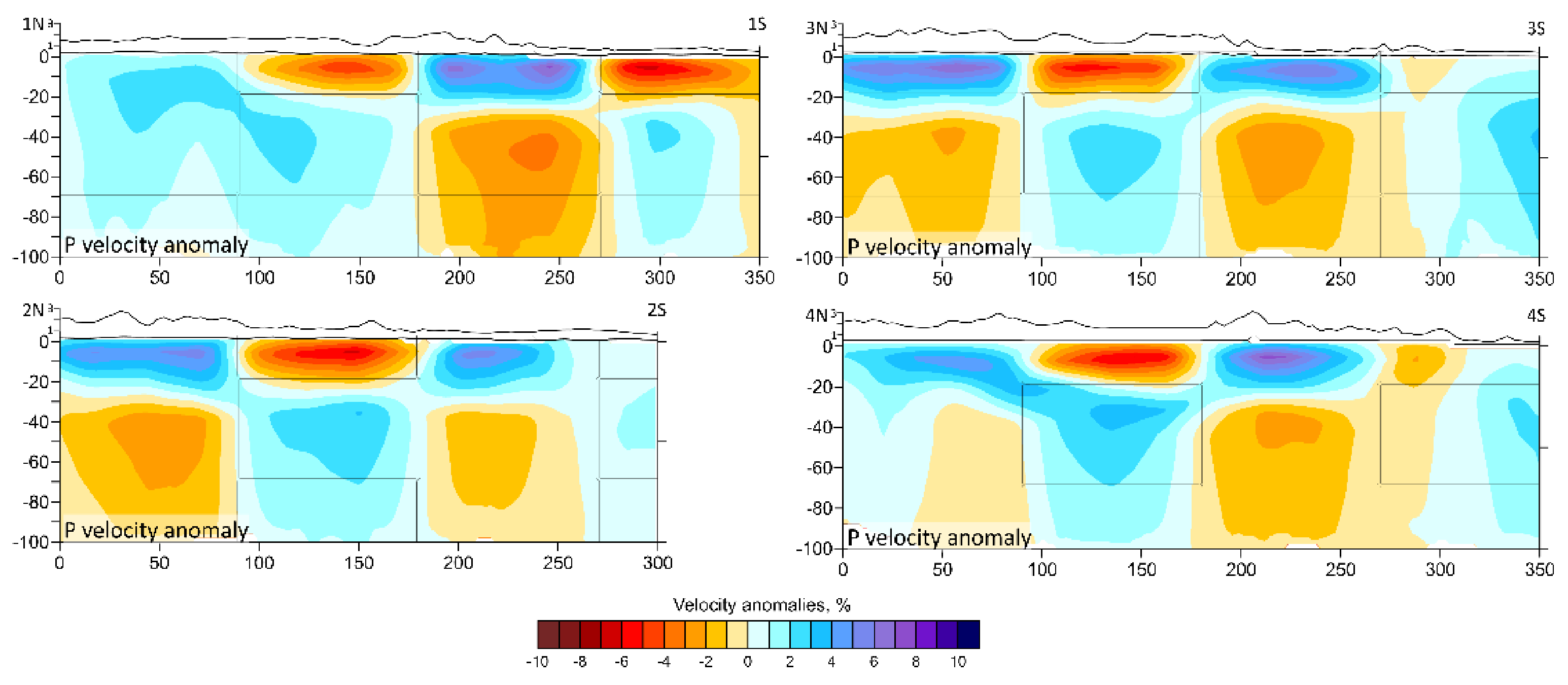

| Depth, km | Vp, km/s | Vs, km/s | Vp, Vs |
|---|---|---|---|
| −5 | 5.5 | 3.3 | 1.66 |
| 10 | 5.89 | 3.39 | 1.73 |
| 20 | 6.12 | 3.61 | 1.69 |
| 30 | 6.51 | 3.8 | 1.71 |
| 40 | 7.2 | 4.22 | 1.70 |
| 60 | 7.71 | 4.51 | 1.70 |
| 120 | 8.2 | 4.6 | 1.78 |
Publisher’s Note: MDPI stays neutral with regard to jurisdictional claims in published maps and institutional affiliations. |
© 2021 by the authors. Licensee MDPI, Basel, Switzerland. This article is an open access article distributed under the terms and conditions of the Creative Commons Attribution (CC BY) license (http://creativecommons.org/licenses/by/4.0/).
Share and Cite
Medved, I.; Polat, G.; Koulakov, I. Crustal Structure of the Eastern Anatolia Region (Turkey) Based on Seismic Tomography. Geosciences 2021, 11, 91. https://doi.org/10.3390/geosciences11020091
Medved I, Polat G, Koulakov I. Crustal Structure of the Eastern Anatolia Region (Turkey) Based on Seismic Tomography. Geosciences. 2021; 11(2):91. https://doi.org/10.3390/geosciences11020091
Chicago/Turabian StyleMedved, Irina, Gulten Polat, and Ivan Koulakov. 2021. "Crustal Structure of the Eastern Anatolia Region (Turkey) Based on Seismic Tomography" Geosciences 11, no. 2: 91. https://doi.org/10.3390/geosciences11020091
APA StyleMedved, I., Polat, G., & Koulakov, I. (2021). Crustal Structure of the Eastern Anatolia Region (Turkey) Based on Seismic Tomography. Geosciences, 11(2), 91. https://doi.org/10.3390/geosciences11020091







